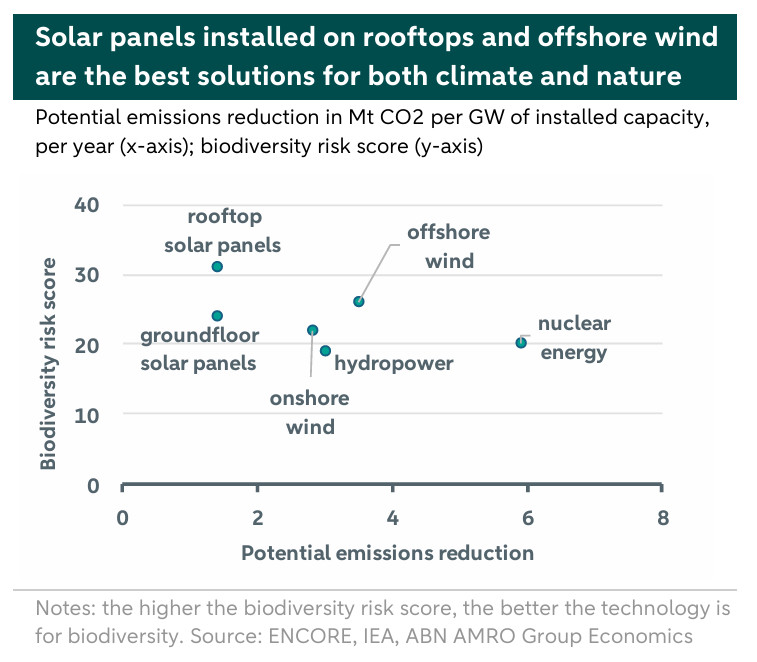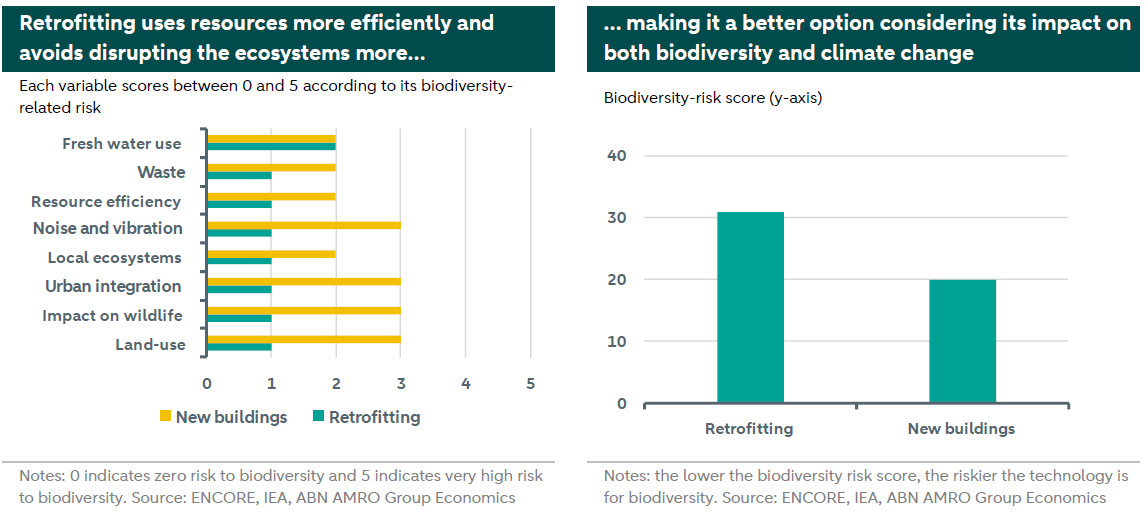ESG Strategist - The climate-nature nexus explained

Climate efforts that overlook nature could cause ecological damage, exacerbating negative climate feedback loops, and heightening the risk of irreversible environmental changes. As a result, the concept of a climate-nature nexus has been gaining increasing attention from researchers. In this note we assess different technologies eligible for financing under use-of-proceeds bonds, and compare them according to both their biodiversity risk and potential emissions reduction.
According to our results, solar panels installed on rooftops are better for nature preservation than ground mounted panels, given the disturbances to wildlife that might occur with large scale land clearing
Similarly, the construction of new houses, despite being in most cases very energy efficient, is worse for biodiversity than retrofitting old buildings given the waste of resources and the additional new land needed
Going forward, banks should include high-quality nature metrics into ESG processes and integrate nature risks in cash flow projections of projects heavily reliant on nature
Between October 21st and November 4th, the 16th Conference of the Parties to the Convention on Biological Diversity (COP16) was held in Colombia, South America. This event marked the first Biodiversity COP following the adoption of the Kunming-Montreal Global Biodiversity Framework at COP15 in December 2022, which aimed to halt and reverse nature loss by 2030. Since then, biodiversity has become a central topic of discussion among countries, corporations, and investors.
Conversely, climate change has been a priority on the global agenda for a longer period. Taking the Paris Agreement as a pivotal moment, next year will mark a decade since climate change has prominently featured in the agendas of world leaders.
Nevertheless, it is impossible to address climate change without considering biodiversity. The concept of the climate-biodiversity nexus is gaining increasing attention from researchers. While restoring and preserving natural ecosystems can benefit both climate action and biodiversity, not all climate initiatives align with biodiversity goals, and some can even be detrimental. For example, the extraction of minerals necessary for the energy transition may be beneficial for climate objectives but can also lead to the degradation of the Amazon rainforest. Therefore, climate efforts that overlook the climate-biodiversity nexus could cause ecological damage, exacerbate negative climate feedback on intact ecosystems, and heighten the risk of irreversible environmental changes.
As such, in today’s note we explain the nexus between climate and nature, and compare different activities usually linked to green bonds considering their impact both on climate change and biodiversity. The aim of this note is to help both issuers and investors in navigating different technologies and projects at the moment of deciding what projects are better suited at tackling both these challenges.
How does the EU Taxonomy approach biodiversity?
The EU Taxonomy is a key component of the European Commission’s Action Plan on Financing Sustainable Growth, launched in 2018 and influenced by the Paris Agreement. While initially developed to address climate change, it also places significant emphasis on biodiversity. Notably, four of the EU’s six environmental objectives are nature-related: (1) sustainable use and protection of water and marine resources, (2) transition to a circular economy, (3) pollution prevention and control, and (4) protection and restoration of biodiversity and ecosystems.
Moreover, the "Do No Significant Harm" (DNSH) principle of the EU Taxonomy ensures that activities deemed sustainable do not negatively impact any of these objectives. Therefore, even if an activity contributes either to (1) climate change mitigation or to (2) climate change adaptation, it must not harm biodiversity-related objectives.
When a “use-of-proceeds” green bond aligns with the EU Taxonomy, the financed projects not only contribute to one of these environmental objectives but also avoid causing harm to the others. However, information on the alignment of companies’ green bonds with the EU Taxonomy remains scarce. That is particularly the case for green bonds issued by banks, given how these entities rely on third-party information that is provided by borrowers. A report by Sustainalytics (see ) indicates that financial institutions are encountering difficulties in completing regulatory templates that include information on their loan book alignment with the EU Taxonomy. This, in turn, leads to a lack of alignment data and poor quality of the available data. As a result, it is hard to assess the proportion of green bonds issued by EU banks that fully align with the EU Taxonomy. However, given that Fitch estimated that only 15% of all green bonds align “at least 75%” with the EU Taxonomy (see ), we deem this share to be relatively low. This highlights the importance of both investors and issuers to conduct additional screening around biodiversity impact when investing in (or issuing) green bonds.
Assessing the climate-biodiversity nexus for green bonds of EU banks
As we previously showed (see here), green bond proceeds issued by EU banks are mostly allocated towards renewable energy and green buildings. As such, we will focus on analysing the nexus between climate and biodiversity for these two green bond categories.
We do so by creating a matrix that maps the interconnection across biodiversity and climate. Important to note that, as investments linked to green bonds, all of these projects should contribute to climate change mitigation. However, some projects should offer greater benefits than others. That is also true for their impact on biodiversity. Some projects may improve climate change without affecting nature, while others positively impact both biodiversity and climate change. These differences in impact should be captured by our matrix. Below, we examine various projects within these categories, comparing their contributions to nature and climate, and rank them based on these outcomes.
To rank projects based on their impact on nature and climate, we first need to develop a model with several variables and assign scores accordingly. We use the ENCORE database (see ) and other sources, such as WWF, to identify key variables relevant to the preservation of biodiversity. The variables considered are:
land use: assesses the land area used by the activity, which can modify and negatively impact terrestrial or sea-land (for example, deforestation for mining purposes);
impact on wildlife: measures the impact that conducting an activity has on wildlife, such as birds, fish, among other (for example, birds and bats might collide against wind turbines);
urban integration: refers to the incorporation of natural elements into urban planning and development (for example, incorporating solar panels or green walls into the design of a city);
local ecosystems: the emission of toxic pollutants (GHG and non-GHG emissions) that can directly harm organisms and the environment, ultimately impacting local ecosystems (for example, nuclear power plants can emit radioactive substances, which could pollute vegetation and lead to decreases in soil productivity);
noise and vibration: economic activities often produce noise, vibration or light pollution that might harm organisms (for example, wind energy production can cause noise pollution from wind turbines);
resource efficiency: measures the use of resources while minimizing the impacts on biodiversity and maximizing the benefits for ecosystems and human well-being (for example, retrofitting a building uses less resources than constructing a new building);
waste: measures the solid waste generated and released by economic activities (for example, nuclear power stations produce various types of solid waste, most importantly hazardous nuclear waste);
fresh water use: assesses groundwater or surface water used to conduct an activity (for example, nuclear power plants and thermal plants have substantial water requirements for their routine operating processes).
Each variable is scored from 1 to 5, where 1 indicates very low risk to biodiversity and 5 indicates very high risk. Once each variable is scored, we sum all the points in order to calculate a biodiversity-risk score. In order to facilitate the interpretation of results, we have subtracted the biodiversity risk score from 40 (the maximum), such that the higher the number the lower the biodiversity risk.
Regarding climate, we rank the different renewable energy technologies based on their potential emissions reduction. This is done so by comparing the technology’s potential emissions reduction to a coal power plant. All numbers were drawn from the International Energy Agency (IEA) and regard annual averages from 2020 (see ). The higher the potential emissions reduction (given in Mt CO2), the higher the climate change mitigation impact of that technology.
Results
Within renewable energy we will focus on the following projects: onshore wind, offshore wind, hydropower, nuclear energy and solar panels installed on the ground floor and on rooftops. Below we plot a matrix comparing the biodiversity risk score and the potential emissions reduction of each technology.

First, we can compare solar panels installed on ground floors with those installed on rooftops. For instance, rooftop installations do not require additional land, which will ultimately preserve natural habitats and ecosystems. Ground-mounted solar farms, on the other hand, can lead to habitat loss and fragmentation. By utilizing existing structures, rooftop solar panels minimize disturbances to wildlife that might occur with large-scale land clearing. Hence, ground installations can alter local ecosystems, affecting plant and animal species. All in all, while both types of solar technologies have the same climate impact (proxied by its potential emissions reduction), rooftop systems pose a significantly lower risk to biodiversity.
Considering the other renewable energies, their biodiversity scores closely range between 19 and 26. The largest difference actually regards their potential emissions reduction. Indeed, nuclear energy stands out among the other options, given that in 2020 it avoided annual direct emissions of 5.9 million tonnes CO2 per GW of installed capacity and displaced fuel. Nevertheless, the direct impacts of this type of energy on wildlife and the environment are not negligible, scoring 20 according to our biodiversity risk measure. For instance, nuclear power plants, especially those using traditional cooling methods, are significant water users. They require large amounts of water for cooling the reactors and condensing steam back into water. This can impact local water resources, especially in areas prone to drought. The water is typically drawn from nearby rivers, lakes, or the ocean, and is returned after cooling, potentially affecting aquatic ecosystems through thermal pollution. Furthermore, nuclear power stations produce various types of solid waste, with hazardous nuclear waste being the most significant. The decommissioning of these stations also generates considerable quantities of both radioactive and conventional solid waste. Although the impact on wildlife is generally considered as low, potential risks from accidents or improper waste management can have severe consequences. Such that, a score of 20 might even be an undervaluation of the true risk, overlooking the tail risks associated with this technology.
Hydropower is also a non-consensual technology given its impact on rivers and the surrounding ecosystems. According to our biodiversity risk measure, hydropower has a score of 19 – the lowest (that is, the riskier) amongst the other technologies. This low score is mainly driven by three different variables: the impact on wildlife, the noise and vibration produced, and the impact of this technology on fresh water use. For instance, hydropower energy production can lead to a large increase in freshwater habitat upstream, and a decrease in freshwater habitat downstream. This alteration of sediment and water flow can result in an increased likelihood of erosion and drought on a local basis. Furthermore, hydropower energy production can cause noise pollution due to the operation of machinery and underground water discharges. Ultimately, this can negatively affect species populations, making this technology a less suitable choice in what regards its biodiversity impact.
It is also important to highlight the differences between onshore and offshore wind energy. Although the technologies are similar, their potential for emissions reduction and their biodiversity risks differ. Offshore wind has a greater potential for emissions reduction, with a recorded reduction of 3.5 million tons of CO2 compared to onshore wind's 2.8 million tons in 2020. Some reasons for this regard the higher wind speeds that are found in the sea in comparison to land. Moreover, offshore locations allow for the installation of larger turbines with bigger blades that can capture more wind energy, given the absence of space constraints and noise concerns that are present on land. Additionally, offshore wind poses a lower risk to biodiversity, scoring higher due to negligible land use and minimal urban integration. In other aspects, both technologies yield similar results. They both face the risk of bird and bat collisions with turbines and can disrupt habitats during construction and operation.

We have not included green buildings in the matrix above because it is quite challenging to compare the avoided emissions of retrofitted buildings and to those of new buildings (for example, these depend on the location of the building, primary energy use of the country, etc). Nevertheless, we can do a qualitative analysis of the risks that each building activity poses to biodiversity. For instance, even if new buildings have an EPC A-label, or are highly energy efficient, they will most likely involve clearing land, which can lead to habitat loss and fragmentation, negatively affecting flora and fauna. Furthermore, new houses will not be supportive of urban density strategies, further deteriorating surrounding natural areas and biodiversity. As such, retrofitting should impose lower biodiversity risks, as it minimizes demolition waste and requires fewer raw materials compared to new construction, reducing the demand for resource extraction that can further harm biodiversity.
Recommendations and conclusion
Finally, here are some recommendations that could assist (green bond) issuers and investors going forward. First, it is important to understand the location oh the activity. Once location is known, issuers and investors can better ensure that the activity is not placed in areas where natural resources are significantly stressed. Additionally, integrating more high-quality nature impact metrics into ESG screening processes can enhance decision-making. For sectors with a high impact on nature (such as agriculture), it is beneficial to include quantitative nature impact metrics in screening procedures. Prioritizing the capture of risks related to deforestation is crucial, given its substantial impacts on both climate and nature. Lastly, in cash flow projections, companies and projects in sectors heavily reliant on nature should consider anticipated nature loss, similar to how they account for climate change, in order to include nature-driven risk channels effectively.
In conclusion, while green bonds have been predominantly centred on addressing climate change, it is crucial to recognize the significant biodiversity considerations that accompany these instruments. Issuers and investors alike must understand that the impact of a green bond extends beyond carbon reduction: ultimately, it is impossible to address climate change without considering biodiversity. By integrating biodiversity objectives into their investment strategies, stakeholders can enhance the positive environmental outcomes associated with green bonds. Ignoring the biodiversity angle risks undermine the ecosystems that support our climate goals. Therefore, it is imperative for all parties involved to consider and act upon the interconnectedness of climate and biodiversity in their pursuit of a sustainable future.
